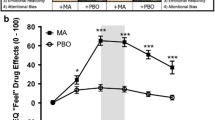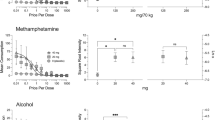Abstract
The ability of a placebo drug capsule to serve as a conditioned reinforcer as a function of being paired with money reinforcement was evaluated. Volunteers were administered two differently colored capsules that presumably contained two different drugs. Although the volunteers were told they might contain a stimulant, sedative, or placebo, both capsules contained only a placebo. During sessions, volunteers participated in performance tasks. The tasks were programmed so that following one capsule, the amount of money obtained contingent upon responding was greater (high frequency of reinforcement) than following the other capsule (low frequency of reinforcement). During experiment 1, participants were exposed twice each to the two reinforcement conditions (sampling). During sessions 6–8, no tasks were done but participants were allowed to choose which capsule they preferred. During these choice sessions, 9 of 12 participants chose the capsule associated with the high frequency of reinforcement 2 or 3 times. Experiment 2 was designed to explore further whether the differential mood effects observed during sampling sessions could be conditioned. Although this could not be demonstrated, the self-administration results demonstrating the control of choice behavior even in the absence of pharmacological effects suggest that drugs may function as conditioned reinforcers. This finding has implications for broadening our understanding of the determinants of initiation and continued drug use.
Similar content being viewed by others
References
Chait LD, Uhlenhuth EH, Johanson CE (1987) Reinforcing and subjective effects of several anorectics in normal human volunteers. J Pharmacol Exp Ther 242:777–783
de Wit H, Johanson CE, Uhlenhuth EH (1984) Reinforcing properties of lorazepam in normal volunteer subjects. Drug Alcohol Depend 13:31–41
de Wit H, Pierre J, Johanson CE (1989) Assessing individual differences in ethanol preference using a cumulative dosing procedure. Psychopharmacology 98:113–119
Goldberg SR, Spealman RD, Kelleher RT (1979) Enhancement of drug-seeking behavior by environmental stimuli associated with cocaine or morphine injections. Neuropharmacology 18:1015–1017
Grant KA, Johanson CE (1988) Oral ethanol self-administration in free-feeding rhesus monkeys. Alcohol: Clin Exp Res 12:780–784
Grant KA, Samson HH (1985) Induction and maintainance of ethanol self-administration without food deprivation in the rat. Psychopharmacology 86:475–479
Griffiths RR, Bigelow GE, Henningfield JE (1980) Similarities in animal and human drug-taking behavior. In: Mello NK (eds) Advances in substance abuse. JAI Press, Greenwich, Conn., pp 1–90
Hawkins JD, Catalano RF, Miller JY (1992) Risk and protective factors for alcohol and other drug problems in adolescence and early adulthood: implications for substance abuse prevention. Psychol Bull 112:64–105
Johanson CE (1978) Drugs as reinforcers. In: Blackman DE, Sanger DJ (eds) Contemporary research in behavioral pharmacology. Plenum Press, New York, pp 325–390
Johanson CE, de Wit H (1989) The use of choice procedures for assessing the reinforcing properties of drugs in humans. In: Fischman MW, Mello N (eds) Assessing the abuse liability of drugs in humans. National Institute on Drug Abuse Monograph Series #92, Washington, D.C., pp 171–209
Johanson CE, Uhlenhuth EH (1980a) Drug preference and mood in humans:d-amphetamine. Psychopharmacology 71:275–279
Johanson CE, Uhlenhuth EH (1980b) Drug preference and mood in humans: diazepam. Psychopharmacology 71:269–273
Johanson CE, Woolverton WL, Schuster CR (1987) Evaluating laboratory models of drug dependence. In: Meltzer HY (eds) Psychopharmacology, the third generation of progress. Raven Press, New York, pp 1617–1625
Kandel DB (1986) Processes of peer influence in adolescence. In: Silberstein R (eds) Development as action in context: problem behavior and normal youth development. Springer, New York, pp 203–228
Kelleher RT (1966) Chaining and conditioned reinforcement. In: Honig WK (eds) Operant behavior: areas of research and application. Appleton-Century-Crofts, New York, pp 160–212
O'Brien CP, Ehrman RN, Ternes JW (1986) Classical conditioning in human opioid dependence. In: Goldberg SR, Stolerman IP (eds) Behavioral analysis of drug dependence. Academic Press, New York, pp 329–356
Samson HH, Tolliver GA, Lumeng L, Li T-K (1989) Ethanol reinforcement in the alcohol nonpreferring rat: Initiation using behavioral techniques without food restriction. Alcohol: Clin Exp Res 13:378–385
Schuster CR (1991) Nathan B. Eddy Memorial Award Lecture. In: Harris LS (eds) Problems of drug dependence 1990. NIDA Research Monograph, Rockville, MD., pp 6–19
Schuster CR, Johanson CE (1988) Relationship between the discriminative stimulus properties and subjective effects of drugs. In: Colpaert FC, Balster RL (eds) Transduction mechanisms of drug stimuli. Springer (Psychopharmacology Supplementum Series), Berlin, pp 161–175
Schuster CR, Woods JH (1968) The conditioned reinforcing effects of stimuli associated with morphine reinforcement. Int J Addict 3:223–230
Schuster CR, Fischman MW, Johanson CE (1981) Internal stimulus control and subjective effects of drugs. In: Thompson T, Johanson CE (eds) Behavioral pharmacology of human drug dependence. National Institute on Drug Abuse Research Monograph Series #37, Rockville, MD, pp 116–129
Wilker A (1961) On the nature of addiction and habituation. Br J Addict 57:73–79
Wikler A, Pescor FT (1967) Classical conditioning of a morphine abstinence phenomenon, reinforcement of opioid drinking behavior and “relapse” in morphine-addicted rats. Psychopharmacologia 10:255–284
Young AM, Herling S (1986) Drugs as reinforcers: studies in laboratory animals. In: Goldberg SR, Stolerman IP (eds) Behavioral analysis of drug dependence. Academic Press, Orlando, Florida, pp 9–67
Author information
Authors and Affiliations
Additional information
The opinions expressed by the authors do not necessary reflect those of the United States Government. The authors would like to thank Ed Bunker, Brenda Campbell, Anne Gupman, and William Rea for their technical and statistical assistance. Portions of these data were presented as a poster at the 56th annual meeting of the College on Problems of Drug Dependence in June 1994
Rights and permissions
About this article
Cite this article
Johanson, C.E., Mattox, A. & Schuster, C.R. Conditioned reinforcing effects of capsules associated with high versus low monetary payoff. Psychopharmacology 120, 42–48 (1995). https://doi.org/10.1007/BF02246143
Received:
Revised:
Issue Date:
DOI: https://doi.org/10.1007/BF02246143




